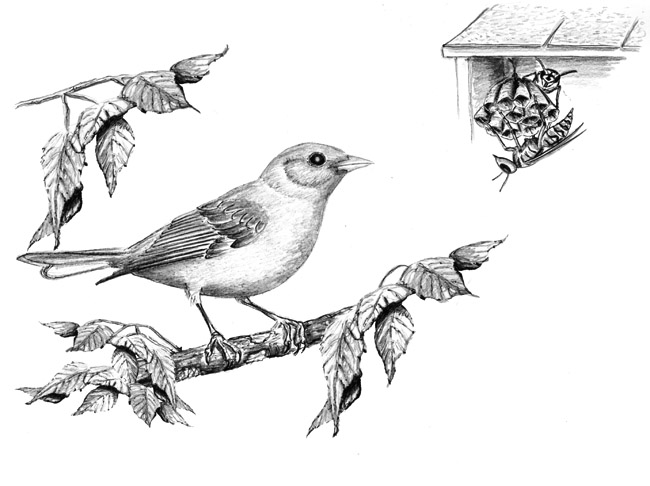
Dear Bird Folks,
Today I saw this bird in my backyard (see attached photo). At first I thought it was a Scarlet Tanager, but after doing a bit of research I now believe it’s a Summer Tanager. Would you be so kind and tell me for sure which bird it is? Thank you.
– Bob, Brewster, MA
Nice manners, Bob,
I can tell you were raised properly. It’s not often I’m asked a question that includes both “thank you” and “would you be so kind?” A lot of the questions I receive are loaded with wisecracks and sarcasm, and sometimes the wisecracks are directed at me. Me! Where does that come from? I’m always so sweet, polite and caring to everyone. I don’t get it. Maybe I should have the IRS look into it.
Your second guess is correct. Even though the image you sent isn’t perfect, I believe the bright red bird in your photo is a male Summer Tanager (either that, or it’s a grackle dressed in a Santa suit). You are lucky to see a Summer Tanager on Cape Cod. They are southern birds and only a handful of lost individuals are seen on Cape Cod each spring. Even though the Cape does have a small breeding population of tanagers, those birds are the equally striking Scarlet Tanagers. In fact, if you look at a tanager range map, which I’m sure everyone has, you’ll see that the breeding ranges of the two tanagers cut North America in half. The northern tier of the continent is occupied by Scarlet Tanagers, while the southern half is inhabited by Summer Tanagers. It’s a cordial agreement that the two birds worked out during the early years of Reconstruction.
Anyone who has been lucky enough to see a male Scarlet Tanager will undoubtedly remember the bird’s flaming bright red plumage. The vivid color on these birds is beyond bright, making our beloved cardinals look like dullards by comparison. However, the male Summer Tanager takes the red plumage to a whole new level, because he doesn’t have the black wings and tail that the Scarlet Tanager has. He is red all over…and not like a newspaper.
It’s interesting that such brilliant-looking birds breed this far north. Aren’t the real colorful birds typically found in the tropics? Well, yes, which is why Summer Tanagers are only here in the “summer.” The rest of the year they are in tropics, hanging out with all of the other tanagers. And when I say “all of the other tanagers” I’m talking about a lot of birds. The Americas have roughly 240 different species of tanagers and many of them are ridiculously colorful, making even Summer Tanagers look like dullards by comparison.
You might think that such luminous birds would be easy to spot, and they are sort of easy to spot in the spring, but once the leaves come out these birds have an uncanny ability to blend in. Thick foliage not only camouflages the tanagers, but it’s also where they find food. Wanna guess what tanagers like to eat? I’ll give you some hints: It’s not leaves. It’s also not anything that you’d ever want to put in your mouth, not even on a bet. Two of the Summer Tanagers’ favorite foods are bees and wasps. Yup, those painful creatures that send the rest of the animal kingdom running for their lives, are yummy snacks for tanagers. When a tanager sees a passing bee (or wasp) the bird will fly out and pick it out of the air. It will then fly to a perch and proceed to beat the snot out of it until it’s good and dead. But the tanager doesn’t eat it right away. The bird knows that even dead bees are still dangerous. So the next step is to remove the stinger, which the bird does by wiping it off on a branch. After that, it’s down the hatch. Why do tanagers crave bees so much? To get their daily requirement of vitamin Bee, of course.
There is actually something that tanagers like to eat even more than bees, and that’s bee larvae. (I’m calling it “bee larvae” because saying that birds eat baby bees sounds too cruel.) The birds will fly up those little paper nests (you know, the ones that look like shower heads, made of little gray cells that are filled with gooey, wormy larvae) and help themselves. If the adult bees try to defend the nest, the birds will help themselves to the adults, too. Summer Tanagers are equal opportunity eaters.
During the summer, Summer Tanagers concentrate on eating insects, but other times of the year they’ll opt for a more balanced diet and will add fruit to the menu. They’ll eat blackberries and blueberries and will also come to feeders that offer over-ripe bananas and peanut butter. Over-ripe bananas not only attract the tanagers but they will also attract bees, which the birds turn into dessert.
Congrats on not only seeing a Summer Tanager, Bob, but getting a photo of it, too. My guess is the bird will stick around for a day or two, rest up, eat a few bees, get its bearings and then turn around and head south, where it should be. Before your tanager leaves, you should offer it an over-ripe banana. But be careful not to add peanut butter to the mix. By offering both peanut butter and bananas, especially in a sandwich, you run the risk of attracting the rare Elvis tanager and you don’t need that. Seeing a tanager wearing a jumpsuit is even creepier than seeing a grackle in a Santa suit.